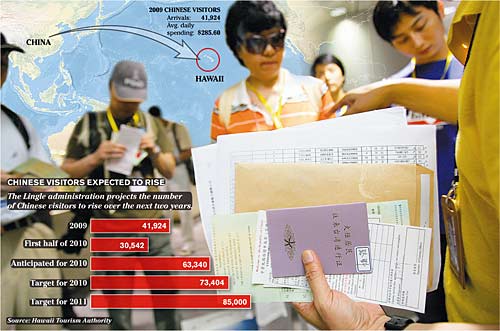U.S. visa process gets easier

Passengers from Beijing prepare passports for customs officers upon arrival at Taiwan Taoyuan International Airport in Taoyuan, Taiwan. Gov. Linda Lingle said yesterday at a Hawaii Chinese Tourism Association luncheon that long visa wait times and rejections are improving for Chinese travelers who want to come to Hawaii.
Gov. Linda Lingle said yesterday that long visa wait times and rejections are improving for Chinese travelers who want to come to Hawaii; however, more must be done to ease the way for the state’s highest spending visitors.
Lingle, who was the keynote speaker at a Hawaii Chinese Tourism Association luncheon, said she is "optimistic" about China’s potential to become a major visitor market to Hawaii. China has the fastest growing visitor outbound market in the world, she said.
"There is high demand and many have the ability to travel," Lingle said. "The U.S. is a preferred destination and Hawaii is one of the top choices."
Although Chinese visitor arrivals to Hawaii grew 47.6 percent during the first half of this year compared with the same time in 2009, Lingle said that arrivals have been limited by a lack of direct flights and by the perception that it is still difficult to obtain the required travel documents. Tourism officials, government leaders and travel operators need to spread the word that visa interview wait times are less than 30 days for nine months out of the year and that the rejection rate is down to 4 out of 5 travelers, she said.
"We need to dispel the perception that visas are difficult to get and that they take a long time," Lingle said.
Chinese visitors to the U.S. must obtain a visa before entering the country and must go through a visa interview at a U.S. visa office as part of the process. Many visa applicants have complained about the difficult process for getting a visa and the large number of applicants who are rejected. Many destinations that compete with Hawaii — including Bali, Phuket and the Maldives — do not require visas for Chinese visitors.
Don't miss out on what's happening!
Stay in touch with breaking news, as it happens, conveniently in your email inbox. It's FREE!
Earlier this week, wait times for U.S. visa interviews ranged from eight days at Gaungdong to 20 days in Shanghai, Lingle said.
"That’s not bad," Lingle said, adding that there have been incremental visa improvements during her time in office, including:
» Visitors are reporting better experiences with the online visa application process.
» Visitors now can apply at any consular office, even on Saturdays.
» Visitors who have already obtained a U.S. visa can bypass the interview on their next trip.
» Visitors can eliminate confusion by bringing tour operators into the interview.
But even with these changes, Chinese travel providers have been hesitant to guarantee prospective carriers airline seats due to lingering doubts about the reliability of the visa process.
While Hainan Airlines has been approved to operate three direct flights between Honolulu and Beijing weekly, the carrier pushed back its launch when tour operators would not guarantee passenger counts, Lingle said. Other carriers could offer charter flights; however, no commitments have been made, she said.
"We have to convince them that they can make money," Lingle said. "One airline has to take the plunge. There are always risks in business."
The visa requirement deters more Chinese travelers than does the lack of direct flights, said C.J. Chen, chief executive officer of BCM International, a Web design, translation and marketing company working closely with Hawaii’s visitor industry.
Chen’s client Hongbin "Robin" Wang, owner of China-based Snowbank and Fitbank Inc., said he had planned to bring a group of eight surfers on a trip to Oahu earlier this month, but that three potential travelers were rejected when applying for U.S. visas.
Destinations that don’t require a visa are more attractive for Chinese visitors who might not understand the differences between Hawaii and other sun -and-surf travel spots, Chen said. And competition will get more robust once Saipan gets visa-waiver status by the end of the year, he said.
"It’s going to be very damaging for Hawaii," he said.
Lingle, who wants to make a fifth trip to China before she leaves office in December, said that getting direct flights and creating an efficient visa process remain top priorities.
"We’re not going to run out the clock," she said. "We’ll continue moving the ball down the field, but you may have to be the ones that take it across."



